In mid-December 2025, the РА "Red Crescent Society of the Republic of Kazakhstan" held a short film competition on the theme "Fundamental Principles o Read more
Quotation gallery
The job of an educator is to teach students to see the vitality in themselves.
Faculty News
On December 26, 2025, the Faculty of History, Economics and Law held a final meeting of the Faculty Council dedicated to summarizing the results of th Read more
17.12.2025 на медицинском факультете НАО СКУ им.М.Козыбаева началась экзаменационная сессия. С целью укрепление принципов академической честности, про Read more
12 декабря 2025 года, в рамках реализации плана научных мероприятий медицинского факультета на 2025–2026 годы, был проведён практический семинар с гру Read more
On December 2, 2025, the Department of Justice of the North Kazakhstan region held a lecture for students as part of the implementation of the ideolog Read more
On November 27, 2025, the Faculty of History, Economics and Law hosted a seminar by business consultant and MBA teacher Sh.I. Orazbayeva on the topic Read more
На факультете прошёл круглый стол со студентами 5 курса фармацевтического профиля на тему «Надлежащие аптечные практики: цели, задачи и подходы к реал Read more
From November 12, 2025 at the medical faculty of SKU named after M. Kozybaev as a visiting professor, prof. Claudio Colosio from the University of Mil Read more
19.11.2025 года на медицинском факультете был проведен круглый стол «Патриотизм как научная и нравственная позиция Манаша Козыбаева», посвящённый дню Read more
Круглый стол «Роль Манаша Козыбаева в развитии гуманитарного образования в Казахстане», посвящённый дню рождения выдающегося казахстанского учёного-гу Read more
Petropavlovsk Teachers' Institute (1937-1955 гг.)
The history of the M. Kozybayev North Kazakhstan state University is inextricably linked with the history of our state, its culture and education. In the formation and development of one of the oldest educational institutions of the Republic of Kazakhstan, the following stages can be distinguished:
- Petropavlovsk Teachers' Institute - 1937-1955;
- Petropavlovsk Pedagogical Institute - 1955-1994.;
- North Kazakhstan state University - 1994-2003;
- M. Kozybayev North Kazakhstan state University - since 2003
The opening of the Teachers' Institute in Petropavlovsk was determined by the tasks of further development of the education system in the region. There were 1,318 schools in the region with 156,656 students. In addition, the region has developed a network of educational institutions for the elimination of illiteracy among adults, which trained more than 35 thousand people. The development of the education system required qualified teachers, their training was conducted by the Petropavlovsk, Kokchetau, Shchuchin pedagogical schools, the total number of students in which was 1,811 people, 924 of them were representatives of the Kazakh nationality.
Petropavlovsk Teachers' Institute was opened on the basis of the decree of the Council of people's Commissars of the Kazakh SSR of March 19, 1937. According to the order of the People's Commissariat of education of the Kazakh SSR No. 835 of July 25, classes began on September 1, 1937 at two faculties: natural geography and history. The Institute did not have its own academic building in the year of its formation. Classes were held in the second shift in the city school building, located at the intersection of K streets.Atusheva and Petranova. The staffing table of the teachers' institute included the director of the institute (P.M. Baranovsky), the deputy director (V.A. Zhirnov) and the teacher (N.F. Vakhonin). Most of the training was conducted by freelance teachers. In the academic year 1937-1938, 211 people studied at the institute, of which 82 were representatives of Kazakh nationality.


In 1939, the Charter was approved, which fixed the official name of the University-Petropavlovsk state Teachers' Institute, and determined the organizational structure. The main structural divisions of the Institute were departments; initially there were five of them: the foundations of Marxism-Leninism, history, geography, natural science, Russian and Kazakh languages. The duties of the heads of departments were performed by: P.S. Andreev - geography, P. F. Marchuk – natural science, K. Baitugaev – history, V. A. Zhirnov - the foundations of Marxism-Leninism, N.S. Ryzhkov-Russian and Kazakh languages. The staff of the Teachers' Institute already had 16 teachers, of whom 13 had higher education, 3 had secondary education.
In the 1938-1939 academic year, the state of the material base improved. The Teachers' Institute was given a new school building (useful area – 129 sq.m) at Partizanskaya street, 48, as well as a former mosque building for a club, a two-story house for teachers' apartments. In addition, on the basis of lease, buildings were transferred for dormitories for students (total area-412.5 square meters). At the end of 1938, equipment for classrooms of history, Zoology, botany, geography, and chemistry was purchased for the amount of 30,465 rubles, and educational materials for 3,633 rubles.
Since 1938, the Correspondence Department of the Institute was opened. Opportunities were created for the successful development of the University, solving issues of teacher training for Northern Kazakhstan. In 1940, the first graduation of the correspondence Department took place; 27 history teachers, 17 geography teachers, and 8 biology teachers received diplomas with the right to teach in lower secondary schools. Many of them later graduated from pedagogical universities and became qualified specialists – S.P. Beev, E.D. Mitsukova, A.A. Gorvits, I.V. Ivanova, etc.
The outbreak of the Great Patriotic War significantly changed the conditions of the university. In connection with the deployment of a number of military factories in the city of Petropavlovsk, the university building was transferred to a radio plant evacuated to the city. Initially, the teacher's institute was located in the school on Chelyuskina Street, in September 1944 he was transferred to the building of secondary school No. 2 named after S.M. Kirov. Along with the deterioration of the material support of the educational process, the issues of staffing the educational process of the university and student enrollment were rather difficult to solve. The staff schedule in the 1943-1944 academic year consisted of 17 people, including two candidates of science – D.M. Sagdiev, G.D. Ovchinnikov; 5 people were involved in part-time work. Taking advantage of the fact that some of the researchers and teachers of the higher school were being evacuated in Petropavlovsk, the Directorate invited them to work. Among them were famous scientists. In 1943, at the Moscow Institute of land management, Igritsky defended his PhD thesis on the topic: "The agrarian question and the peasant movement in Russia in 1917". After the defense, the author of the study for several years, while in evacuation, worked at the Peter and Paul teachers ' Institute. At the same time, during the great Patriotic war, the practice of forming a teaching staff from among graduates developed. Thus, graduates R.K. Akberdin and N.B. Shlykov were left. They worked as assistants for a number of years, while studying in absentia at the Omsk pedagogical Institute. This practice continued after the end of the war: in 1946, she was left as an assistant at the Department of history. Vaskova, in 1948 - as an inspector of correspondence education E.F. Rauche.

Despite the difficulties of wartime, the Petropavlovsk teachers ' Institute managed to maintain a contingent of students: in the 1941-1942 academic year, there were 168 people, in 1944-1945-198 people. Some reduction of the contingent in the 1941-1942 academic year was caused by the mobilization and voluntary departure of students to the front. In total, during the great Patriotic war, 41 people left the University for the front, including 13 teachers and 28 students. Among the defenders of the Motherland were the teachers of the Institute, headed by the Director of the Petropavlovsk Teachers' Institute, S.M. Linkov: U. Zemlyatdinov, A. Kovalev, M. Bazilevsky, S.N. Chulkov, I. V. Ivanovsky, N. F. Vakhonin; students: N. Artemyev, A. Rodin, D. Borgul, G. Vakulin, P. Smirnov and others. Numerous facts testify to their courage and heroism on the fronts of the great Patriotic war. In the battles for the Motherland, the Director of the Institute, S.M. Linkov, was seriously wounded. Voenruk I.V. Ivanovsky commanded a regiment of the 314th rifle division, defended the city of Leningrad. For participation in the great Patriotic war, the teacher S.N. Chulkov was awarded the orders of the Patriotic war of the 1st and 2nd degree, the red Star, and battle medals. In the battles for the Motherland, the teacher N.F. Vakhonin, students S.Zhunusov, A. Kovalev, A. Smirnov, A. Tsesak died heroically.

During the war years, the staff of the Teachers' Institute made a significant contribution to the training of personnel in the military specialties demanded by time. During the years of the war, the Institute trained 55 nurses, 35 instructors of the PVHO, 150 radio communications specialists. In the initial period, training was carried out in circles, in the 1943-1944 academic year, this training was already provided for by the curriculum.
Students and teachers took an active part in Sundays for grain processing at elevators, clearing railway tracks from snow drifts. The entire staff of the institute participated in the harvest, deducting all earnings - annually 5-6 thousand workdays - to the country's defense fund. The staff of the institute was an active participant in all voluntary actions that took place during the Great Patriotic War: sent 622 units of warm clothes to the front, collected 24,142 rubles for the purchase of warm clothes for the front, 10,920 rubles for tank columns and air squadrons, conducted monetary and clothing lotteries, having collected 41060 rubles for the front, he participated in the acquisition of bonds of state defense loans for 246 496 rubles; contributed bonds to the defense fund in the amount of 61458 rubles; 17577 rubles were contributed to the assistance fund for Leningraders, the Oryol region, and children of war veterans.

In October 1944, the structure of the university changed. According to the curriculum of 1944, the Faculty of History was transformed into the Faculty of History, Russian Language and Literature. In 1945, this faculty was reorganized into a historical-philological one. In the conditions of the post-war period, the university was allowed to accept students on the basis of 9 classes, which made it difficult to provide high-quality training for specialists.
Recognizing the contribution of the Petropavlovsk Teachers' Institute to Victory in the Great Patriotic War, the government praised the merits of the staff of teachers and students. In 1945, the institute was named after the great teacher of the XIX century K.D.Ushinsky. In a teacher’s institute, among the pedagogical community of the city of Petropavlovsk, propaganda of his heritage unfolded. A thematic city lecture was organized, where lectures were given on the topics: “K.D. Ushinsky on the education of attention and memory”, “K.D. Ushinsky on the education of habits”, “K.D. Ushinsky on the development of oral and written speech”; in city schools, discussions were held about the life and work of K.D. Ushinsky; book exhibitions were organized in the regional library and the library of the teacher's institute.

In the postwar period, the contingent of students increased significantly. In the infrastructure of the teacher's institute, 14 groups of students were formed: philologists, physicists, mathematicians; from them - 7 groups of the 1st course and 7 groups of the 2nd. Lectures on general institutional disciplines: the foundations of Marxism-Leninism, pedagogy, psychology, school hygiene - were carried out in streams. In 1948, due to a shortage of teachers of physics and mathematics, a physics and mathematics faculty was opened. The curriculum of the teacher's institute provided for the following distribution of hours: the study of socio-political disciplines - 12% of the total number of hours, pedagogy and psychology - 10%, special disciplines - 60-65%; up to 9% of teaching time was allocated to pedagogical practice, 13% of the volume of theoretical study of special disciplines was devoted to field practice. In addition, the Kazakh language was studied at all faculties, and the comparative grammar of the Russian and Kazakh languages was also studied at the philological faculty. Due to the additional hours, the skills of oral and written speech were sufficiently deeply grafted: dictations were regularly conducted, work on mistakes was carried out, which made it possible to increase the culture of speech of the future teacher. Teaching disciplines was carried out in Russian. If necessary, for graduates of Kazakh schools, in order to better adapt, temporary groups were created until the end of the first half of the year, which were then transferred to general flows.
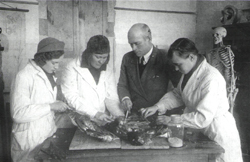
During this period, the teacher's institute was located in the school building on Kirova street. There were 10 classrooms in the educational building, 3 of which were designed for 75-100 people, 7 - for 20-25 people. Classrooms of zoology, biology and chemistry were located in these classrooms. A special room was allocated only for a physical laboratory. In the afternoon, one of the classrooms became a reading room. There was no gym in the room, physical education classes were held outdoors or in a rented room. In 1949 alone, the Ministry of Education allocated 175 thousand rubles for the overhaul of the educational building. These funds were allocated for the installation of steam heating, the construction of a boiler room, and fencing of the territory.
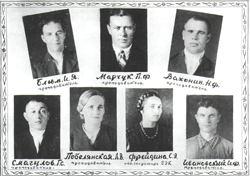
The institute on a rental basis used two buildings for student dormitories. Both buildings were quite dilapidated and lacked communal amenities. Part of the buildings was occupied by teachers' apartments. Nonresident students for the most part rented private apartments.
Near the building of the Teacher's Institute on Kirov street, 37, the Department of natural sciences with the help of students was broken educational-experimental site. In the spring of 1950, four varieties of wheat, two varieties of mustard, millet, oats, and barley were sown on it; a flower garden was placed; experience in introducing vegetable crop rotation was carried out.
Together with resolving issues of developing the material base and organizing training sessions, the institute’s management sought to significantly improve the qualifications of the faculty. The issue of staffing was rather complicated for a provincial university, which was the Peter and Paul Teacher Institute at the time of its formation. Candidates of Sciences were G.D. Ovchinnikov, G.B. Gorvits, D.M. Sagdiev. The administration of the university through the ministry decided on the issue of assigning applicants to the central universities of the republic.
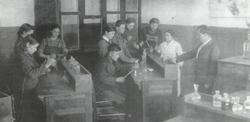
But research work was sometimes constrained by social factors that influence the content of the educational process. Political events, public campaigns that characterized the life of Soviet society of this period, often determined the priorities of scientific research. The views of certain scientific areas, scientists, whose opinions did not coincide with party assessments of statesmen, were subjected to public obstruction. So, in December 1950, after the publication of the article “For the Marxist-Leninist Coverage of the History of Kazakhstan” in the Pravda newspaper, an industrial meeting was held with the participation of teachers and students, discussions were held in study groups in connection with the appearance of the work of E. Bekmakhanov “Kazakhstan in 20–40 years of the XIX century ”, containing an assessment of the movement of Kenesary Kasymov. A special order of the Ministry of Education of the Kazakh SSR banned the study of the theme "Highlanders' struggle for independence under the leadership of Shamil" and questions about Kenesary Kasymov, Nysambai. At the same time, a widespread study of the works of I.V. Stalin on linguistics was imposed.

Despite the difficulties arising in the process of the formation of the university, the staff of the institute did everything possible to implement the main strategy in education. The university leadership paid special attention to recruitment issues. Students and teachers spoke on the radio, on the pages of newspapers talked about the work of the teacher. The educational department collected lists of graduates of Kazakh secondary schools in the North Kazakhstan region and established a written link with each graduate. Many events were aimed at attracting young people, especially Kazakh, and in particular - Kazakh girls. In April 1950, for the first time, an open day was held at the institute with the invitation of students from city schools and teacher training schools. During the meeting, students talked about pedagogical specialties, demonstrated experiments in educational laboratories, and a concert was shown by their forces for guests. In order to attract youth, preparatory courses were organized at the teacher's institute. So, in the 1945-1946 academic year, one-year courses were organized for Kazakh youth with 30 students. Much attention was paid to the issues of employment of graduates. After graduation, young distribution specialists were sent to work in the North Kazakhstan, Kokchetau, Akmola, Karaganda, Semipalatinsk, East Kazakhstan, Kustanai, Pavlodar regions.

The teacher institute actively collaborated with public education authorities and educational institutions of the city and region. The traditional form of work with past graduates working in schools was the holding of pedagogical conferences at the university. So, in June 1951, a conference was held “Preventing academic performance and combating second-year schooling in the Soviet school", which was attended by 67 people working as teachers in the North Kazakhstan, Akmola, East Kazakhstan, Karaganda regions, as well as students of the Petropavlovsk Teachers' Institute. In the academic year 1951-1952, the department of pedagogy in the secondary school No. 2 of the city of Petropavlovsk hosted a seminar for class teachers, at which reports on moral education, the fight against formalism in educational work, and the methodology for conducting student and parent meetings were heard. Specialists of the departments conducted seminars for teachers on the study of history, biology, and geography.
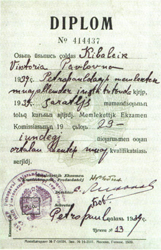
Of particular importance in the training of teachers in the early 50s began to acquire teaching practice. The traditional basic schools for conducting the practice were urban secondary seven-year schools (No. 1, 6, 2, 4, 5). There, students got acquainted with the experience of teachers, attended the lessons, they themselves had to conduct different types of lessons, learn to analyze them. Pedagogical practice was carried out in 2, 3, 4 semesters. In the second semester, students got acquainted with the pedagogical process, performed tasks on school hygiene. In the third semester, they got acquainted with the school process for 1 day a week with exemption from classes. In the fourth semester, students underwent active practice as a teacher and class teacher. The educational subgroup at the school observed 10-12 lessons, each student gave 4-9 lessons, during the teaching practice, students conducted 15-20 extracurricular activities. Since 1951, the leadership of the teacher's institute has been practicing the conclusion of agreements with schools for conducting pedagogical practices.
Significant place in the organization of research work was assigned to field practices. For several years, the issue of conducting scientific research on the history, flora and fauna of the North Kazakhstan region was not resolved, only the physical and geographical features of the region were studied with the active participation of G.D.Ovchinnikov. In 1953-1954 he was the director of the institute, but in 1954, due to illness as a result of a wound received during the Soviet-Finnish war, he transferred to the post of head of the department of geography. In the academic year 1946-1947, field trips on his initiative organized expeditions to study the natural resources of the Leninsky and Priishimsky regions of the North Kazakhstan region.
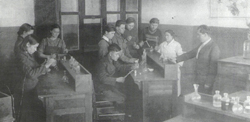
In the post-war period, an attempt was made to develop a comprehensive theme “North Kazakhstan Region”. It was assumed that all departments of the institute would take part in the development of individual sections. The Department of Geography will study the geographical data of the region, the Department of Natural Sciences - flora and fauna, the Department of History will prepare a series of essays on various periods of the region’s history, the Department of Russian Language and Literature will present local dialects, and will collect folklore materials. The result of the development of this topic was to be a collection of works on the North Kazakhstan region, but the implementation was carried out only in the departments of geography and natural sciences. The stated level of the complex theme was beyond the strength of the teaching staff of the teachers' institute of those years.
However, the research activities of the university were at a fairly high level. Students were actively involved in it. Their scientific work was carried out through scientific circles. There were 6 such circles - at the departments of history, geography, natural sciences, the Russian language and literature, physics, mathematics - with the number of participants from 40 to 50 people. Moreover, the most gifted students had independent research topics. Back in the pre-war era, first-year student students R. Akberdin, F. Krucher, V. Erzakovich participated in a republican scientific conference dedicated to the 20th anniversary of the Kazakh SSR. In the post-war period, interesting works were presented by G. Suslov “On finds of fossil fauna and flora in the North Kazakhstan region” and P. Radishevsky “On the grass-field system of crop rotation and useful forestation on the collective farm named after V.R. Williams of the Mamlyut district of the North Kazakhstan region”.
The educational work of that time was dominated by mass political events. The training schedule included weekly political activities. Every month, faculty and institute student Komsomol and trade union meetings were held. Significant place was given to holding reader conferences on literary works marked by state awards: in 1949, based on the novels by S.P. Babayevsky “Cavalier of the Golden Star” and V.N. Azhayev “Far from Moscow,” in 1950, on the novel by Yu.V. Trifonova "Students".
A society for the dissemination of political and scientific knowledge was created at the Teacher's Institute. Every Saturday, a lecture hall worked for students; its subjects included philosophical, enlightening, political, and general cultural problems: “Climate change in the modern era”, “Life and work of the great Russian physiologist I.P. Pavlov", “The origin of man,” “Pedagogical ideas of A.S. Makarenko”, “On the culture of youth behavior”, “On friendship and partnership” ,“On the structure of the Universe”, etc.
A significant place in educational work was occupied by amateur circles. Creative teams of the teacher's institute took first places in city and regional amateur art shows. The groups of choral singing were especially famous: Russian four-voice, Kazakh, Ukrainian; string ensemble, accordion ensemble, drama circle. With the participation of creative teams of the teacher's institute, city events were held, individual performances of soloists were broadcast on the radio.
At a fairly high level was set sports work. It was conducted through the Bolshevik voluntary sports society. For sporting achievements, the staff of the Teacher Training Institute was awarded the Red Banner in the city championships in skiing, athletics, and swimming. The Institute staff was the owner of four regional prizes - for the championship in relay races, swimming, and athletics. In republican contests DSO "Bolshevik" of the Petropavlovsk Teachers' Institute repeatedly took first place for organizing sports activities. The merits of sports disciplines M.S. Bazilevsky, A.A. Schlegel were especially noted.
Thus, the glorious path of the formation and development of the university over two decades was marked by significant milestones in labor victories and achievements. During this time, the university staff was headed by well-known scientists, honored figures of the education system. The directors of the teacher's institute were: P.M. Baranovsky (1937-1939), S.M. Linkov (1939-1941), A.A. Kerber (1941), L.V. Pobelyanskaya (1941-1944 ), A.V. Belyomytsev (1945), S.P. Terentyev (1945-1951), P.D. Prisich (1951-1953), G.D. Ovchinnikov (1953-1954), A.M. Mamyrbaev (1954-1955).
However, the level of incomplete higher education did not meet the requirements of the education system in the North Kazakhstan region. The task of obtaining universal 7-year education, the lack of teachers with higher education, required an increase in the level of university training. In the early 50s, the leadership of the university and the region began to consider prospects for the growth of the status of a teacher’s institute and its reorganization into a pedagogical institute.
In 1946, the total population of the region was 364.7 thousand people, including urban - 101.1 thousand people, workers' settlements - 14.8 thousand people, rural - 248.8 thousand people. In the North Kazakhstan region there were 540 schools, of which 24 were urban. In addition, in Petropavlovsk and the region there were mechanical, agricultural, veterinarian, land management technical schools, a pedagogical school, a feldsher school, an agricultural education school in the village of Tokushi, and an agricultural technical school in the Leninsky district.
The need has ripened for a radical reorganization of the university and a change in its status. There were necessary conditions for this. The quality of training at the teacher's institute was at a fairly high level. Academic performance in the 1954-1955 academic year was 95%, only 20 people had academic debt, or 5% of the total number of students; There were 274 people doing excellent and good, which was 67.5%. In the early 50s, the candidates of physical and mathematical sciences T.D. Goldstein, S.G. Turitov, the candidate of pedagogical sciences I.Ya. Garms came to work at the university. Candidate of Philological Sciences, associate professor A.E. Sinerukov, graduate student of the postgraduate studies I.I. Devitsky and a graduate of the university T.A.Rot began work in the mid-1950s. The material base was strengthened: the educational building on Pushkin Street began to be built. All this served as the basis for the reorganization of the university from teacher to teacher.

